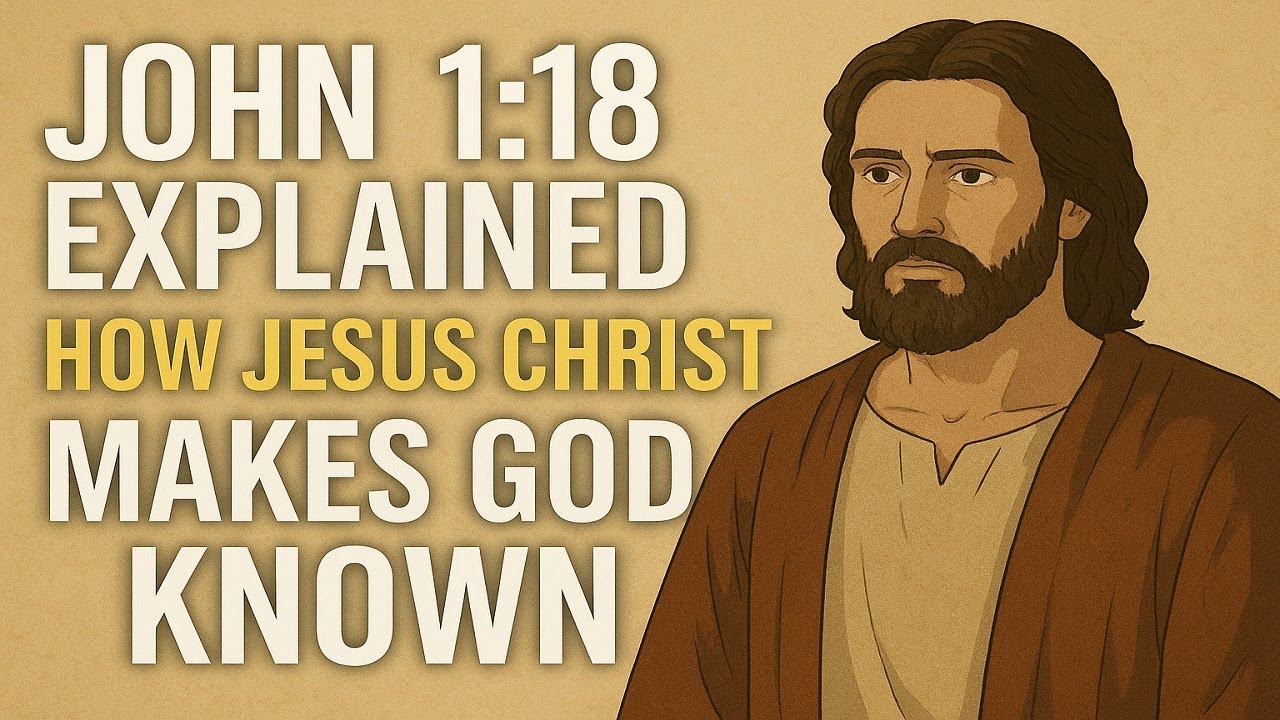We’ve all been there. Staring up at a vast, star-filled sky, feeling small, wondering about the big questions. Who is God? What is He really like? Can a person even know Him? We chase answers in philosophy, in nature, in religion, but a complete picture always seems just out of reach.
The book of John, however, opens with a jaw-dropping claim: the infinite, invisible God has actually been seen. He’s been perfectly revealed. This incredible reality is wrapped up in a single sentence. This article is a deep dive into John 1:18 explained, showing how this one verse completely changes our understanding of seeing the unseeable. This isn’t just theological poetry.
It’s a verse that builds a bridge between us and God, the finite and the infinite. John 1:18 is the very foundation for a real relationship with the Creator of the universe. It’s the key that unlocks the entire story.
More in John Chapter 1 Category
Key Takeaways
- God is Spirit: John 1:18 starts by establishing a core truth—no one has ever seen God in His pure, essential form. His very nature is beyond what our physical eyes can perceive.
- Jesus is Unique: The verse calls Jesus the “only God” or “only Son,” emphasizing His completely one-of-a-kind nature and relationship to the Father. He isn’t just a son; He is the Son.
- An Unbreakable Bond: The phrase “in the bosom of the Father” paints a picture of the deepest possible intimacy, closeness, and perfect union between Jesus and God the Father.
- The Great Explainer: Jesus’ core mission, according to this verse, is to “make Him known.” The original Greek word is to “exegete” or explain fully. Jesus is the perfect interpretation of who God is.
Why Does the Bible Say No One Has Ever Seen God?
The verse kicks off with a blunt statement that can be confusing: “No one has ever seen God.” Anyone who has read the Old Testament might immediately think of exceptions. Didn’t God walk with Abraham? Didn’t Moses speak with Him “face to face”? What about Isaiah seeing the Lord on His throne in the temple?
Yes, all of that happened. But they never saw the raw, unfiltered essence of God’s glory.
It’s a bit like the sun. We see and feel the sunlight, and we can make out its shape in the sky. But we can’t stare directly into its fiery core; it would instantly blind us. In the same way, God’s infinite holiness and power are simply too much for a finite, sinful person to experience directly and survive. When Moses begged to see God’s glory, God told him, “you cannot see my face, for man shall not see me and live” (Exodus 33:20). Instead, God tucked Moses safely in the cleft of a rock, letting him see only the afterglow of His glory passing by.
Those Old Testament encounters were powerful and real. They were true manifestations of God, often called theophanies. But they were never the full picture. John 1:18 confirms this truth. It sets the stage by reminding us of a fundamental human limitation. We can’t cross the gap to see God on our own. We needed someone to do it for us.
What Makes Jesus the “Only Begotten Son”?
Right after stating that God is unseen, the verse gives us the solution: “the only God, who is at the Father’s side.” Many translations say “the only begotten Son.” While the phrasing differs due to tiny variations in the oldest Greek manuscripts, the meaning is the same. The Greek word at the heart of it is monogenēs.
For a long time, this was simply translated as “only-born.” Modern scholarship, however, shows it means something much richer: “unique,” “one-of-a-kind,” “in a class of His own.” Jesus isn’t God’s Son in the same way Christians are called “children of God.” We are adopted into the family by grace. Jesus, however, is the Son because of His very nature. His sonship is eternal, inherent, and utterly unique. He shares the same divine being as the Father.
This uniqueness changes everything. Because Jesus is Himself God and has always existed with the Father, He knows God in a way no created being ever could. He doesn’t just know facts about God; He knows God from the inside out. He is the only one in all existence who can perfectly reveal the Father, because He is one with the Father.
What Does ‘At the Father’s Side’ Really Mean?
The verse gets even more personal with the phrase “who is at the Father’s side,” or more literally, “in the bosom of the Father.” This language isn’t about physical location, like two people sitting in chairs. It’s a picture of the deepest possible love, intimacy, and shared identity.
It makes me think of my own father. He was a quiet man, not one for big emotional speeches. To many, he seemed a bit stern. But I knew a different side of him. I remember sitting in his workshop for hours, often in complete silence, just being with him. In those moments, I understood his heart—his worries and his dreams—in a way that went beyond words. That shared closeness gave me a unique insight. I was, you could say, in his “bosom.”
That’s a pale reflection of what John is describing here. Jesus exists in a state of perfect, unbroken fellowship with the Father. He intimately knows the Father’s character, His will, His very heart. It’s not knowledge from a book; it’s knowledge that comes from an eternal bond of perfect love. This ultimate intimacy is what makes His revelation of God completely trustworthy. He’s speaking from the inside.
So, How Exactly Does Jesus “Make Him Known”?
This brings us to the powerful conclusion of the verse: “he has made him known.” This is the mission accomplished. The invisible God is now revealed. The specific Greek word John chose for “made him known” is exēgēsato.
If that word rings a bell, it’s because we get our English word exegesis from it. Exegesis means to critically explain or interpret a text. A good preacher doesn’t just read a Bible passage; he exegetes it. He unpacks the meaning, clarifies the context, and makes the truth of the passage understandable.
That is precisely what Jesus does for God.
He doesn’t just hand us a theological textbook or a list of divine attributes. Jesus exegetes God. He lives out God’s character in a human body, drawing out the meaning of who God is so we can finally grasp it.
I nearly failed physics in college. Quantum mechanics was a foreign language to me. The textbook was just a collection of abstract symbols. Then I got a professor who was a genius at making things clear. He didn’t just rattle off formulas. He used analogies, he drew diagrams, he told stories. He took these impossibly dense concepts and exegeted them. He made them known. For the first time, it clicked. Jesus is that brilliant professor for the subject of God.
Can We See God’s Character in Jesus’ Actions?
If Jesus is the living exegesis of God, then His life is our textbook for knowing the Father. When you look at Jesus, you see the character of God displayed in a way our human minds can process.
Every single thing Jesus did and said was a direct revelation of the Father.
- Want to see God’s compassion? Look at Jesus reaching out to touch a leper—an outcast no one else would go near—and making him whole. That is the Father’s compassion made visible.
- Want to see God’s forgiveness? Watch Jesus defend the woman caught in adultery, telling her, “Neither do I condemn you; go, and from now on sin no more.” That is the Father’s mercy in action.
- Want to see God’s power? See Jesus stand up in a boat and calm a deadly storm with just a command. That is the Father’s authority on display.
- Want to see God’s love? Look at Jesus on the cross, willingly dying for the very people who screamed for his execution. As academic sources like the University of Pennsylvania’s Department of Religious Studies highlight, this idea of divine, sacrificial love became the bedrock of Christian faith. That is the ultimate explanation of the Father’s love.
The life of Jesus is a living, breathing demonstration of God’s character. He translates the divine language into human terms we can finally see, hear, and understand.
Is Seeing Jesus the Same as Seeing the Father?
It all builds to a staggering conclusion that Jesus Himself would later state. When his disciple Philip said, “Lord, show us the Father, and that will be enough for us,” Jesus’ response was pointed.
“Have I been with you so long, and you still do not know me, Philip?” he asked. “Whoever has seen me has seen the Father” (John 14:9).
That is the promise of John 1:18 fulfilled. Jesus is the perfect image of the invisible God (Colossians 1:15). He isn’t a lesser being or a different god. He is the exact imprint of the Father’s nature. This doesn’t mean the Father and Son are the same person; the Bible maintains their distinction. But they are absolutely one in their essence, their will, their character, and their purpose. The character traits you see in Jesus—the love, holiness, justice, and grace—are the very character traits of God the Father.
So when you want to know what God is like, you don’t have to rely on guesswork or abstract philosophy. You look at Jesus.
What Does This Mean for Us Today?
The truth of John 1:18 isn’t just an interesting theological concept. It changes everything about how we can approach God right now.
It has direct, practical implications for our lives:
- The Gospels are your starting point: To know God better, the most direct way is to dive into Matthew, Mark, Luke, and John. When you study the life of Jesus, you are studying the character of the Father.
- It’s about relationship, not religion: Christianity isn’t about following a complex set of rules to appease a distant god. It’s about a real relationship with the Father, made possible through the Son who revealed Him.
- You can pray with confidence: We aren’t just sending words out into the cosmos. We are praying to the Father of Jesus Christ. We can approach Him knowing He is the loving, merciful Father that Jesus showed us.
- You can stop striving: We don’t have to figure God out on our own or try to earn His approval. He took the first step. He did the work to reveal Himself to us in the most complete way imaginable: His Son.
The God Who Wanted to Be Known
John 1:18 is the grand entrance to the Christian faith. It takes on our biggest spiritual problem—that God is invisible—and presents the ultimate solution: the unique, intimate, and revealing person of Jesus Christ.
The God of the universe is not playing hide-and-seek. He isn’t some cosmic riddle to be solved. He is a Father who has gone to incredible lengths to make Himself known to us. He sent His one-of-a-kind Son, who knows His very heart, to live here and to explain Him to us. In Jesus, God has been fully revealed. The only question left is, will we look?
FAQ – John 1:18 Explained

What practical significance does John 1:18 have for believers today?
It encourages believers to study the Gospels to understand God’s character through Jesus, emphasizing the importance of developing a relationship with God rather than merely following rules. It assures us that we can pray confidently to the loving Father revealed in Jesus and that God’s ultimate goal is to be known and loved by us.
How does Jesus ‘make God known,’ and what does this imply about our understanding of God?
Jesus ‘exegetes’ or explains God through His life and actions, embodying God’s character in human form. This means that by observing Jesus, we gain a clear, tangible understanding of God’s nature—His compassion, mercy, power, and love.
What does ‘at the Father’s side’ mean in John 1:18?
The phrase symbolizes the deepest intimacy and unity between Jesus and the Father, reflecting perfect love and shared identity. It indicates that Jesus, in His divine nature, exists in a close, loving relationship with God, enabling Him to fully reveal God’s character.
What makes Jesus the ‘Only Begotten Son’ and how does this affect our understanding of His relationship with God?
Jesus is called the ‘Only Begotten Son’ because He shares an eternal, unique divine nature with the Father, making His sonship inherent and singular. Unlike believers who are adopted into God’s family, Jesus’s relationship with the Father is innate, allowing Him to know and reveal God from within.






